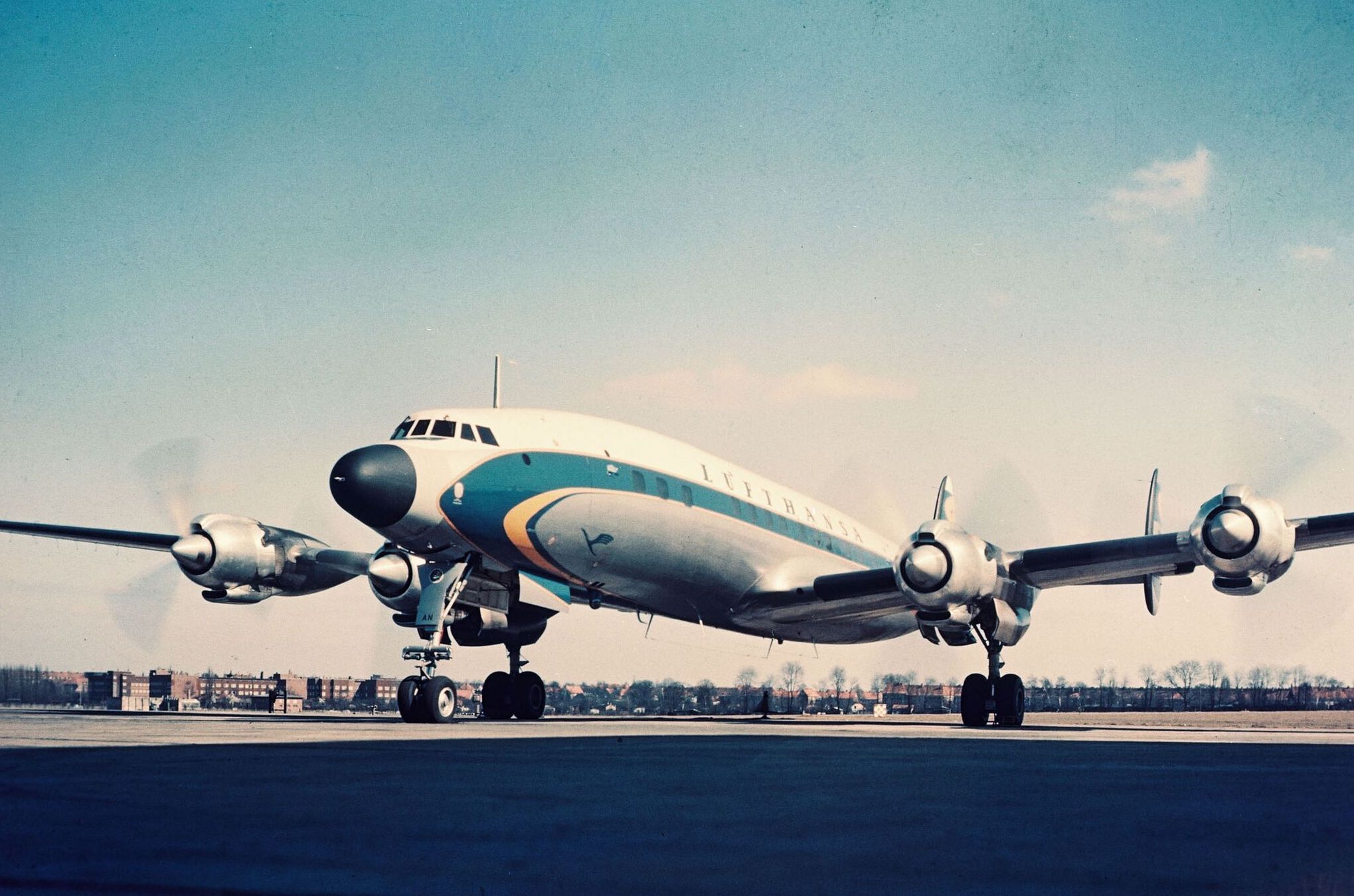
We knew a decades-long process to make a Lockheed Constellation airworthy again was scrapped, but now we know how much it cost…and that amount is staggering.
Lufthansa Aimed To Make Lockheed Constellation Airworthy Again
Lufthansa once aimed for a fully-restored Lockheed Constellation to complement its Junkers Ju 52. The plan was to offer heritage/scenic flights in Germany on these historic aircraft.
Lufthansa acquired two Constellations in 2007 at an auction in the USA. It moved the aircraft to Auburn-Lewiston Municipal Airport (LEW) in Maine and brought in a team to fix the aircraft.
For over a decade, experts painstakingly worked to restore the aircraft. During some periods, more than 100 people at a time were working on it. These were aircraft engineering experts commanding pricey hourly rates.
But in 2018, Lufthansa suddenly scrapped the project. One of the Constellations was sold to the TWA Hotel at New York JFK, where it nows houses a cocktail bar. The other was packed up in boxes and sent to Germany.
Cost overrun was blamed for the project, but we never actually learned how much Lufthansa spent…until recently.
WGME, a CBS affiliate near LEW notes that Lufthansa CEO Carsten Spohr admitted that €150 million ($163 million) was spent on the failed restoration effort.
Ralph Pettersen, who manages ConnieSurvivors.com, a website dedicated to the Constellation, explained what might have happened:
“Everything had to be better than new, which meant that the airplane’s structure and skin was just about totally replaced…90% of the sheet metal had been replaced and upwards of 75% of the structure had been replaced. They basically replaced the entire wing structure and skin. Then they got offered a ‘free’ C-130J type glass cockpit that turned out to be a nightmare with integrating it to the rest of the airplane’s analog systems. In addition to the material and touch labor, they probably spent an absolute ton of money on engineering.”
CONCLUSION
The aircraft now sits in Germany, likely never to fly again. That itself is sad enough, but the fact that Lufthansa spent €150 million and essentially failed in its mission is even sadder.
> Read More:Lufthansa Offers A Chance To Experience Golden Age Of Travel
image: Lufthansa




*sigh*
Wow, so full of errors and you simply don’t seem to understand how aircraft are built, restored or how they fly. OK, a few basics…
Fixing old airplanes is expensive, really expensive. A large, complex airliner like a Constellation has tens of thousands of parts, many of them unique to that plane, some unavailable anywhere at any price. A few could be bought from boneyards/aircraft junkyards, but if you are going to the expense and trouble of doing a serious restoration, those won’t do (I own an old airplane, and while I’m OK using a knob or an interior trim piece from a boneyard for my old plane, it’s not going in a museum or being shown to paying visitors). So there are going to be countless parts you have to make from scratch, one at a time…heck, simply finding the materials to make them from is daunting and expensive. And very much a specialty kind of work – you just don’t drive the plane down to your local Lockheed Dealer and order a replacement part. Second – and here’s where you really show your ignorance – historic aircraft are restored all the time, and in many cases they are restored to original (or better than original) condition, but then are never flown. Yep. Because they are considered too valuable to take the risk of flying them. Flying is tough on machines. Vibration, hard landings, all the stresses of flight, wear and tare on big engines – all take their toll. Maintaining a large, complex, old plane is a huge ongoing project with stunning costs (I have a hard time believing that any sane large corporation would actually take the public on rides on such a plane – cooler heads would have prevailed at some point when someone took a hard look at the risks and potential liabilities). So often, a plane may be restored to “like new” condition, it may fly one time – typically form the restoration location to it’s final display destination, then it’s put on display and will never move again under its own power. This is more common than you would think. All of this is incredibly risky (I know of a huge old airliner, a bit older than the Connie, that was painstakingly restored for many years at a cost almost as high as that of this project…it was heart-breakingly beautiful…once finished, it took off and flew a short distance, was headed for the place it would be displayed, then had to ditch in the ocean and was lost). These are vastly complex machines, and stuff happens.
If Lufthansa sunk 163 million into this project, and they still have the plane (even if it’s still in crates), it’s complete nonsense to say the “got nothing”. That’s petulant and childish. They have a (presumably) beautiful, pristine, very historic aircraft in mint condition – maybe in crates, but re-asembling the thing is the easy part. If it never gets off the ground again, sure, that would be a disappointment to many, but you are completely missing the bigger point: they saved this historic relic, made it “like new” again, and in the coming years many people will be able to see it, touch it, experience it, and appreciate it, even if that’s in a museum.
Do you think the Smithsonian’s National Air and Space Museums (including the Udvar-Hazy Center) https://airandspace.si.edu/collections
“have nothing” because they don’t fly the Spirit of Saint Louis or the Apollo 11 command module or let you ride in them?
A rare, historic flying machine is only valuable in your eyes if you can sit in it up front in business class and hand your dinner jacket to a flight attendant while you sip some champagne?
Tsk tsk. Pearls before swine…
You totally miss the point. The point was not that Lufthansa has nothing. It was that they spent $163MN for what could have been accomplished for so much cheaper (i.e. make it a museum). I’m sad about this. I don’t blame LH for trying. But it must hurt to spend so much and get so little in return…
The Boeing evidently did fly again.
https://products.kitsapsun.com/archive/2002/03-31/0042_boeing_307_stratoliner__historic_.html#:~:text=AUBURN%20%28AP%29%20–%20More%20than%20seven%20months%20after,More…%5D%20Stratoliner%20may%20have%20been%20low%20on%20fuel
I am old enough to have flown in those planes. They were quite the aircraft in the day.
Yes, they were indeed the aircraft of the day. The Cadillac of the reciprocating engine.
In my collection of TWA memorabilia is a Constellation ad featuring a photo of Elizabeth Taylor and husband Mike Todd, stretched-out on their StarStream Siesta Seats.
Sadly, Mike Todd would soon die in the crash of his private plane, ‘The Liz’, and Howard Hughes would provide Taylor with a Connie to fly her privately from Los Angeles to Todd’s funeral in Chicago.
I think the plane referred to as ditching and being lost was actually raised and re -restored.
The real mistake was the very idea that it could fly again, with real passengers. That meant that they had to go to extreme measure ( ie cost) to make it relatively safe.
A far better idea would have been to restore it to original condition, but not airworthy, so that visitors could experience it on the ground. Maybe €20 million, and well worth it.
I just saw a video of a restored Swiss ex- US military Connie on a sightseeing flight from Hamburg w/ 40 passengers. It shows the whole flight. Check YouTube.